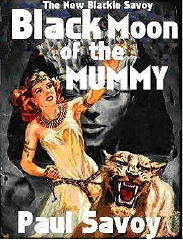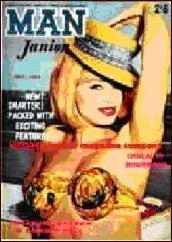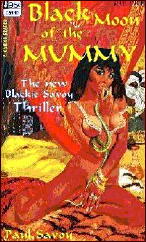Thu 15 Apr 2010
Reviewed by David L. Vineyard: PAUL SAVOY – Black Moon of the Mummy.
Posted by Steve under Reviews[3] Comments
PAUL SAVOY – Black Moon of the Mummy. A Kiwi Crime Classic: Kiwi Press, hardcover, 1959. Also published as Moon of the Mummy and Shadow of the Mummy. Serialized in Man Junior in three parts as “Blackie Savoy and the Mummy’s Curse.” Several paperback editions exist, provenance unknown. Adapted for the Blackie Savoy comic book. Trade paperback: Kiwi Revival Press; adapted for an eight part serial on the The Adventures of Blackie Savoy radio series and in a two-parter for the Blackie Savoy television series.

“I don’t believe in coincidences,” Blacke said, kneeling on the other side of the dead woman. He reached down to examine something near the girl’s neck.
“You have something?” Dupont asked with a trace of excitement in his Gallic voice.
“Do you have a pencil, Inspector?” The Frenchman reached in his jacket pocket and produced a slim silver mechanical pencil. Blackie took it and used it to remove something lying under Fatima’s throat. When he held it up to the light it was revealed as a scrap of dirty cloth.
“What is it?” Dupont asked.
“I think,” Blackie said staring intently at the scrap of cloth, “the police lab will find it is linen, treated with chemicals, and I would guess about three thousand years old.”
“Non!” Dupont exclaimed.
“Oh, yes, my friend. The mummy’s shroud.”
Readers who have read the article on Paul Savoy and his creation Blackie Savoy (announced previously here on the blog) may be interested in this one, a look at what many consider his best book, Black Moon of the Mummy.
In this one Blackie is tagging along with Wanda, his long time lover, who for a change isn’t merely arm candy. Wanda has taken a movie job in a major production for eccentric fat British director and gourmand, Elwood Hotchkiss. The film, Nights with Nefertiti, is the story of the legendary queen, mother of Tutankhamen and wife of the apostate pharaoh Akenaten.
The film is based on a racy novel by Burton St. James, a hard drinking Oxford scholar who is less than happy his book is being butchered by the cavalier Hotchkiss.
“Good,” Blackie said. “We can’t have the only murder this early in the business. I’d hate to think all we had to contend with is a belly dancer strangled by a three thousand year old mummy. Positively boring, that.”

The movie is being made on location in Egypt, in a massive recreation of the city of Amarna near the Valley of the Kings. Dawas Ben Ali is a local historian and Egyptian official horrified by the liberties being taken with his countries history by the book and film; Neal Wilde is the actor playing Akenaten, a closeted homosexual trying to hold on to his looks and status as a leading man; and Althea Lovington is a legendary actress cast as Akenaten’s mother and less than happy that Wanda seems set to replace her as a screen sex symbol.
Anyone of them might have had a motive to murder Fatima. Ben Ali to sabotage the film (Fatima had a small but key role); Neal Wilde, who had been humiliated when he tried to seduce the belly dancer in order to disprove accusations of his homosexuality; Althea Lovington, who may have had Sapphic designs on the sexy dancer; and either the fat Hotchkiss whose advances had been spurned by Fatima or St. James who had made a drunken pass at her at a cast party the night she died.
But Blackie suspects something darker and more dangerous:
“Perhaps,” Blackie said. “But I wouldn’t rule him out, Inspector. Maybe I am being paranoid and seeing master criminals popping up out of the shadows, but I smell a super villain’s hand in this, and no hand stinks of blood as much as Humbert Morphy’s.”
And, as usual, Blackie is right. Morphy’s fine Irish hand is indeed involved, for the film has built its recreation of Akenaten’s city of Amarna on the site where Morphy believes he has located the lost tomb of Nefertiti, and the fabulous riches buried with her. He has been behind the murder of Fatima — she stumbled on one of him as he was spying on the film set, and responsible for the ‘accidents’ on the set as well as the sightings of the black shrouded mummy that guards the tomb.
Blackie tracks Morphy down to the lost tomb, but Morphy gets the drop on him.
“I wouldn’t count my amphora before I had stolen them,” Savoy said. ” You should ask our friend there behind you, first.”
“Friend? Oh — you think to trick me into looking behind me. Tell me, Savoy just who is supposed to be behind me. Inspector Dupont? I happen to know our Gallic friend is in Cairo calling on the Egyptian police. Miss Delicht? She is at the cast party you skipped out on. So, my dear Savoy, just who is supposed to be lurking behind me?”

“I don’t know his name,” Blackie said, his face quite white. “But I should say he was the mummy left to guard Nefertiti’s tomb.”
Morphy’s laughter barked like a hyena. “Really Savoy. A mummy. How childish. Don’t you know it was I who planted the pieces of shroud at the site of the crimes? As for the appearances of the mummy, the fellow I hired for that role is resting comfortably in the belly of some crocodile in Nile by now. Surely you can do better than that.”
“I wish I could oblige you,” Savoy said. “But I think our visitor has taken it all out of my hands, Professor.”
And at that moment a linen shrouded hand fell upon Morphy’s shoulder.
Incidentally this isn’t the spoiler it may seem, because Savoy has one last trick up his sleeve for us and Blackie.
Black Moon of the Mummy is one of the rarest of the Savoy titles, but perhaps the one most worth the effort. It is Savoy at his best, eccentric, fast paced, and often wickedly funny. Despite the thriller elements Blackie does some actual detection, and the finale is a stunner, apocalyptic and thrilling:
“And very nearly his last one,” Wanda said gripping his arm tightly as if still frightened he would somehow be lost to her.
Blackie patted her hand reassuringly. “Now, now,” he said. “I’m not going anywhere. And I suspect neither is our old friend Morphy.”
“But Morphy, this time he is dead, certainly,” Dupont said, circumnavigating the English language in his usual manner.
But Blackie was looking out across the starry skied desert as it spread before him, and of what his thoughts were at that moment no man can write, as he stared into the vastness of history seeing something neither Wanda nor Dupont could perceive, looking into the distant past and the not so distant future.
No. This much he knew. Humbert Morphy lived!
Editorial Comments: The article about Blackie Savoy and his creator, Paul Savoy, that David refers to in the first paragraph of this review, following that short lead-in excerpt, has caused quite a stir in the world of crime fiction bibliography.
Until David’s article appeared, Paul Savoy had somehow managed to avoid the scrutiny of the even the keenest collectors of crime and thriller fiction, nor do his books appear in the Revised Crime Fiction IV, by Allen J. Hubin.
It would seem that his work had vanished from existence, and in fact from the memories of everyone who should have known better. Now, however, a great-great-grandnephew has surfaced (scroll down to the comments), thanks to David’s newly published research into the life and writing career of Paul Savoy.
Not only that, but this nephew of this unjustly forgotten author claims to have discovered a closet full of both books he wrote and magazines he wrote for. It is mindboggling, to say the least, but all preliminary investigations indicate that there is a good deal of revision that needs to be done in terms of who wrote what in terms of previously unquestioned facts about Australian-based detective and thriller fiction.
These are exciting times.
April 15th, 2010 at 5:28 am
As some of you know I am related to the infamous Collyer Brothers and a rumor has circulated among pulp collectors that I have inherited their collecting flaws, etc.
At any rate I have found some copies of MAN JUNIOR buried among my men’s adventure magazines and I have all three issues containing the Blackie Savoy adventure that David discusses above. Unfortunately, some crazed collector has neatly excerpted all three parts of the Paul Savoy novel. A long time collector friend of mine has a habit of doing this and I checked with him but he denies all knowledge of Paul Savoy. The hunt goes on…
April 15th, 2010 at 2:25 pm
That puts Savoy in good company, then. I thought crazed collectors only did this excerpting thing with famous authors, such as Hammett, Burroughs and Arthur Leo Zagat.
— Steve
April 15th, 2010 at 7:51 pm
Who else but a crazed collector would cut the Blackie Savoy serial out of a copy of MAN JUNIOR — considering the rest of the content.